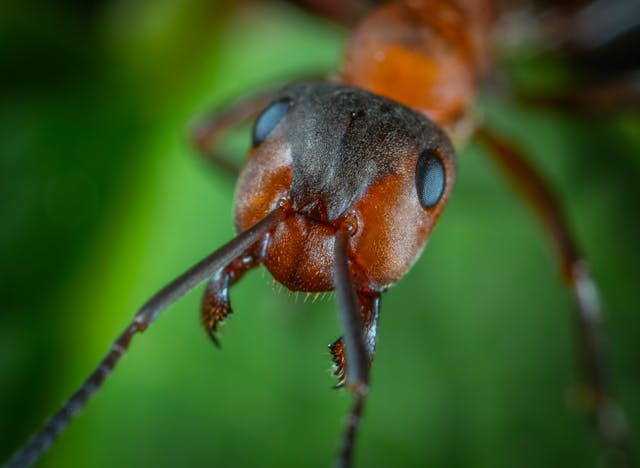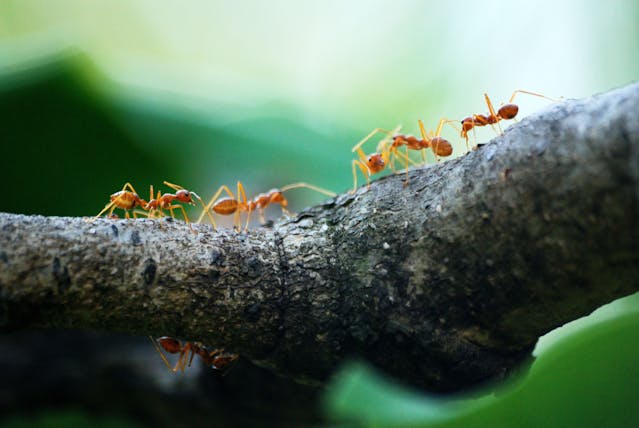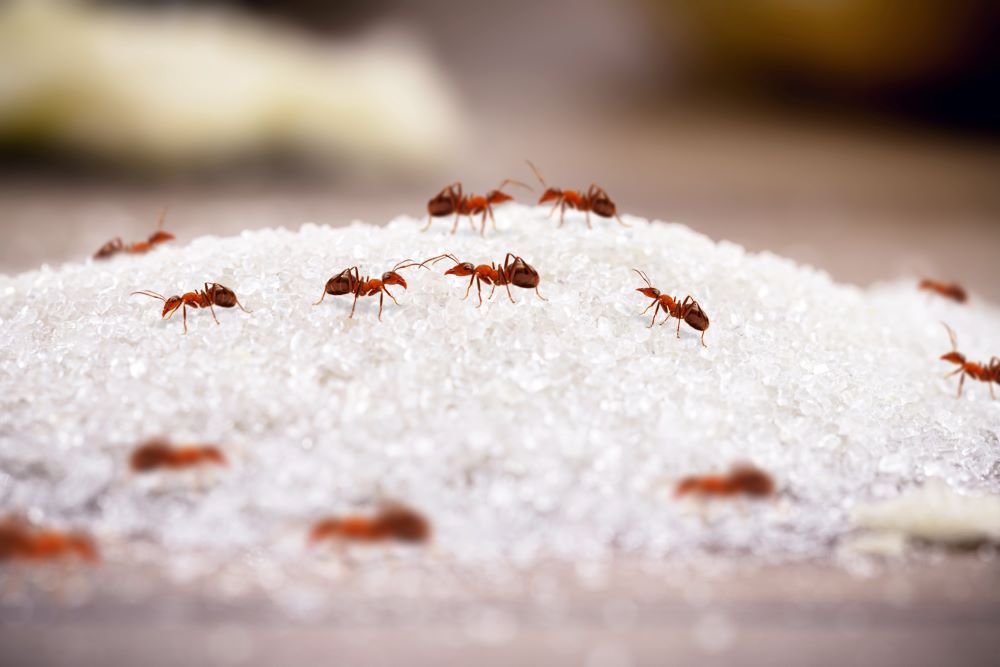Flying ants can be quite a surprise, especially when they suddenly swarm inside or outside your home. In Arizona, these pests pop up during certain times of the year, usually during the spring and early fall.
These pests are generally harmless, but their presence may indicate underlying pest or home structural issues. Understanding flying ants, why they appear, and how you can manage them can help your pest control efforts.
This blog will cover everything you need to know about flying ants in Arizona. Keep reading, and remember to contact Green Magic Pest Control when you notice a pest problem!
What are Flying Ants?
Flying ants, also known as alates or swarmers, are the winged reproductive members of ant colonies. Unlike workers who spend their lives foraging or within the nest, these ants have wings that allow them to take flight and find mates.
Once they mate, female ants shed their wings and begin establishing new colonies. Most of Arizona’s common ant species produce these swarmers, like carpenter ants, pavement ants, and fire ants.
Appearance and Characteristics
While some of their visual characteristics may vary depending on the species, flying ants can be identified by their wings, which are typically longer than their bodies and have a noticeable vein pattern.
These wings are often translucent and can glisten in the sunlight. Besides the wings, flying ants have a body structure similar to that of their wingless counterparts, with segmented bodies and elbowed antennae. However, their primary function during this stage is reproduction, which sets them apart from the worker ants you usually see foraging for food.
Life Cycle
Flying ants are an integral part of the ant colony’s life cycle, representing the reproductive phase that ensures the colony’s continuity. Understanding their lifecycle provides insight into their behavior and the timing of their appearance.
- Egg Stage: The life cycle begins with the queen ant laying eggs. Existing working ants care for these eggs and ensure they’re kept in optimal conditions to develop. The eggs then hatch into larvae, which are fed and protected by the worker ants.
- Larval Stage: The larval stage is a period of growth and transformation. Larvae are nurtured with food from the worker ants, including proteins and other nutrients necessary for their development. During this stage, larvae depend entirely on the worker ants for sustenance and protection.
- Pupal Stage: After the larval stage, the ants enter the pupal stage, where they undergo metamorphosis. They transform into adult forms during this period, including developing wings for flying ants.
- Alate Stage: The final stage for flying ants is the alate stage. Environmental conditions, like warm weather and high humidity, trigger this stage.
When Do Flying Ants in Arizona Appear?
Flying ants typically appear seasonally, with their emergence closely tied to specific environmental conditions. This phenomenon in Arizona often occurs during late spring and summer when temperatures are warm, and humidity levels are high. These conditions create the ideal environment for flying ants to take flight and mate.
Nuptial flights are synchronized events in which flying ants from various colonies take to the air simultaneously. This mass emergence increases the chances of successful mating and genetic mixing.
After mating, the males usually die, while the fertilized females, or future queens, land, shed their wings, and begin establishing new colonies. The new queens find suitable nesting sites to start new colonies, continuing the ants’ lifecycle.
Common Flying Ant Species in Arizona
Several ant species in Arizona produce flying ants. Each species has unique characteristics and behaviors that influence their impact on the environment and their interaction with humans.
Carpenter Ants
Unlike termites, which consume wood for nourishment, carpenter ants excavate it to create their nests. While not as destructive as termites, these pests can still cause significant structural damage to homes and other wooden structures.
Carpenter ants are typically bigger than other ant species, measuring around half an inch to one inch in length. They come in various colors, including black, red, or a combination of both. Their segmented bodies are usually dark-colored, with some species exhibiting reddish hues.
Like their size, carpenter ant colonies tend to be large with complex social structures. They are highly organized and efficient at foraging and nesting. Carpenter ants are skilled builders, creating extensive networks of tunnels and galleries within wood structures.
Carpenter ants prefer nesting in moist, decaying wood, but they can also infest dry wood if conditions are suitable. They often target areas with water damage or high humidity, like bathrooms, kitchens, and basements. Once inside, they excavate tunnels and chambers to create their nests, weakening the structural integrity of the wood over time.
Pavement Ants
Pavement ants are tiny, measuring around one-eighth to one-quarter of an inch in length. They have dark brown to black bodies with parallel lines on their head and thorax. Pavement ants can be aggressive when defending their colonies despite their small size.
They engage in territorial disputes, often with fierce battles to defend their nests. This aggressive behavior can sometimes lead to conflicts with humans, especially if their nesting sites are disturbed or threatened.
As their name suggests, pavement ants prefer to nest in soil under pavement, rocks, and concrete slabs. They construct elaborate networks of tunnels and chambers underground, where they raise their brood and store food.
While they may not directly threaten buildings like carpenter ants, pavement ants can still be a nuisance, especially when they invade homes searching for food.
 Fire Ants
Fire Ants
Fire ants are among the most notorious ant species for their painful stings and aggressive behavior. These pests are easily recognizable by their reddish-brown coloration, contrasting with their darker abdomen.
They are similar in size to pavement ants, measuring around one-eighth to one-quarter of an inch in length. However, don’t let their size fool you; fire ants pack a powerful sting.
These ants are highly aggressive and will defend their colony against perceived threats, delivering painful stings to intruders. Their venomous sting can cause intense pain, swelling, and, in some cases, allergic reactions in humans and animals.
Fire ants construct large mounds in sunny, open areas such as lawns, fields, and parks. These mounds can vary in size, with some reaching several feet in height. The mound’s interior consists of tunnels and chambers where the ants raise their larvae and store food.
Eliminating Flying Ants in Arizona
If you have a flying ant infestation, here are some steps you can take to manage it:
- Identify the Source: Determine where the ants are coming from. Look for nests inside your home or in the surrounding yard.
- Use Baits and Traps: Ant baits and traps can effectively control ant populations. Place them near entry points and along ant trails to attract and kill the ants.
- Professional Pest Control: If you have a severe infestation or DIY methods are ineffective, consider contacting a professional pest control service.
For one-of-a-kind ant pest control in Chandler, AZ, and the surrounding areas, give us a call!


 Fire Ants
Fire Ants
 In Arizona, encountering bugs like spiders, scorpions, and bed bugs can be more common than you’d think. This comprehensive guide will illuminate what to expect, from the venomous to the merely bothersome, ensuring your home stays protected.
In Arizona, encountering bugs like spiders, scorpions, and bed bugs can be more common than you’d think. This comprehensive guide will illuminate what to expect, from the venomous to the merely bothersome, ensuring your home stays protected.